

Compact Muon Solenoid
LHC, CERN
| CMS-HIN-16-024 ; CERN-EP-2018-097 | ||
| Measurement of the groomed jet mass in PbPb and pp collisions at ${\sqrt {\smash [b]{s_{_{\mathrm {NN}}}}}} = $ 5.02 TeV | ||
| CMS Collaboration | ||
| 14 May 2018 | ||
| JHEP 10 (2018) 161 | ||
| Abstract: A measurement of the groomed jet mass in PbPb and pp collisions at a nucleon-nucleon center-of-mass energy of 5.02 TeV with the CMS detector at the LHC is presented. Jet grooming is a recursive procedure which sequentially removes soft constituents of a jet until a pair of hard subjets is found. The resulting groomed jets can be used to study modifications to the parton shower evolution in the presence of the hot and dense medium created in heavy ion collisions. Predictions of groomed jet properties from the PYTHIA and HERWIG++ event generators agree with the measurements in pp collisions. When comparing the results from the most central PbPb collisions to pp data, a hint of an increase of jets with large jet mass is observed, which could originate from additional medium-induced radiation at a large angle from the jet axis. However, no modification of the groomed mass of the core of the jet is observed for all PbPb centrality classes. The PbPb results are also compared to predictions from the JEWEL and QPYTHIA event generators, which predict a large modification of the groomed mass not observed in the data. | ||
| Links: e-print arXiv:1805.05145 [hep-ex] (PDF) ; CDS record ; inSPIRE record ; HepData record ; CADI line (restricted) ; | ||
| Figures | Summary | Additional Figures | References | CMS Publications |
|---|
| Figures | |

png pdf |
Figure 1:
Groomed jet momentum fraction $ {p_\mathrm {T,g}} $ in pp (left) and the 10% most central PbPb collisions (right) for jets with 140 $ < {{p_{\mathrm {T}}} ^\text {jet}} < $ 160 GeV and $ < \eta _{\text {jet}} > <$ 1.3. The pp data are compared to simulation using the PYTHIA event generator and the PbPb data are compared to the same PYTHIA events embedded in PbPb events simulated with the HYDJET event generator. Vertical lines indicate size of statistical uncertainty. The parameters used for the SD algorithm are $ {z_{\text {cut}}} = $ 0.5, $\beta = $ 1.5. The jets are selected based on the ungroomed jet transverse momentum. |
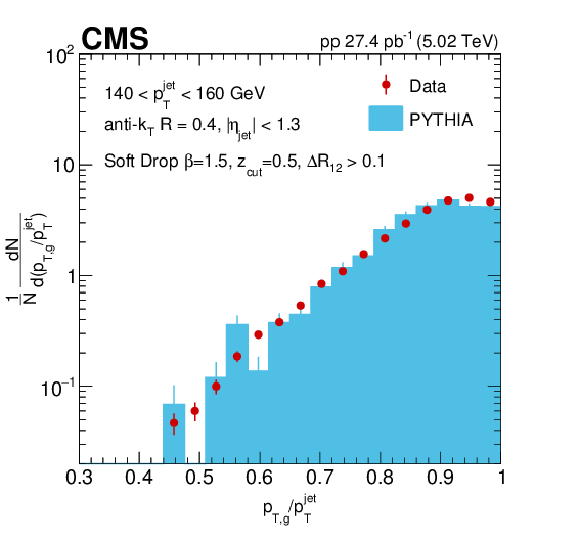
png pdf |
Figure 1-a:
Groomed jet momentum fraction $ {p_\mathrm {T,g}} $ in pp collisions for jets with 140 $ < {{p_{\mathrm {T}}} ^\text {jet}} < $ 160 GeV and $ < \eta _{\text {jet}} > <$ 1.3. The data are compared to a simulation using the PYTHIA event generator. Vertical lines indicate size of statistical uncertainty. The parameters used for the SD algorithm are $ {z_{\text {cut}}} = $ 0.5, $\beta = $ 1.5. The jets are selected based on the ungroomed jet transverse momentum. |

png pdf |
Figure 1-b:
Groomed jet momentum fraction $ {p_\mathrm {T,g}} $ in 10% most central PbPb collisions for jets with 140 $ < {{p_{\mathrm {T}}} ^\text {jet}} < $ 160 GeV and $ < \eta _{\text {jet}} > <$ 1.3. The data are compared to the same PYTHIA events embedded in PbPb events simulated with the HYDJET event generator. Vertical lines indicate size of statistical uncertainty. The parameters used for the SD algorithm are $ {z_{\text {cut}}} = $ 0.5, $\beta = $ 1.5. The jets are selected based on the ungroomed jet transverse momentum. |

png pdf |
Figure 2:
The spectra of $ {{M_{\mathrm {g}}} / {{p_{\mathrm {T}}} ^\text {jet}}} $ for pp events with 160 $ < {{p_{\mathrm {T}}} ^\text {jet}} < $ 180 GeV using (0.1,0.0) SD setting (left panels) and (0.5,1.5) SD setting (right panels). Results are compared to PYTHIA and HERWIG++ event generators. The ratio of simulation to data is also shown. The heights of the gray boxes indicate systematic uncertainties. Statistical uncertainties are less than the marker sizes. |

png pdf |
Figure 3:
(left) The centrality dependence of $ {{M_{\mathrm {g}}} / {{p_{\mathrm {T}}} ^\text {jet}}} $, for PbPb events with 160 $ < {{p_{\mathrm {T}}} ^\text {jet}} < $ 180 GeV for the (0.1,0.0) SD setting. Results are compared to the smeared pp spectra. (right) The ratio of PbPb data over smeared pp data. The heights of the vertical lines (colored boxes) indicate statistical (systematic) uncertainties. Statistical uncertainties are less than the marker sizes in most bins. |
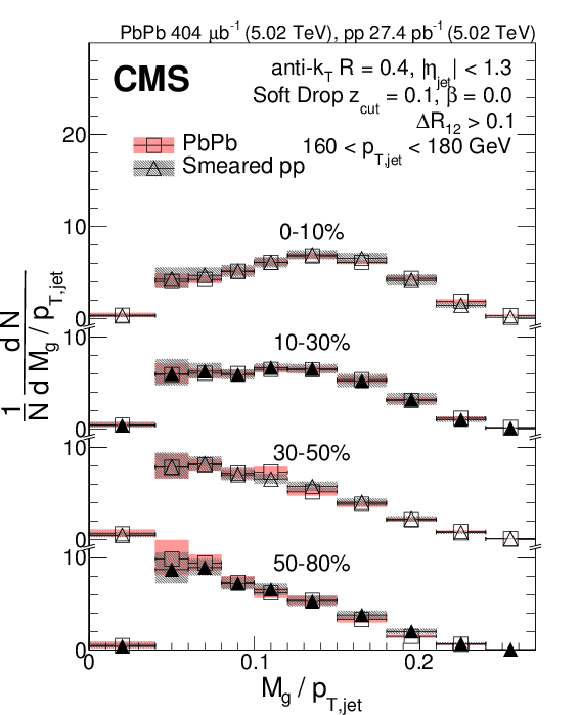
png pdf |
Figure 3-a:
The centrality dependence of $ {{M_{\mathrm {g}}} / {{p_{\mathrm {T}}} ^\text {jet}}} $, for PbPb events with 160 $ < {{p_{\mathrm {T}}} ^\text {jet}} < $ 180 GeV for the (0.1,0.0) SD setting. Results are compared to the smeared pp spectra. Figure 3-b |

png pdf |
Figure 3-b:
(left) The centrality dependence of $ {{M_{\mathrm {g}}} / {{p_{\mathrm {T}}} ^\text {jet}}} $, for PbPb events with 160 $ < {{p_{\mathrm {T}}} ^\text {jet}} < $ 180 GeV for the (0.1,0.0) SD setting. Results are compared to the smeared pp spectra. (right) The ratio of PbPb data over smeared pp data. The heights of the vertical lines (colored boxes) indicate statistical (systematic) uncertainties. Statistical uncertainties are less than the marker sizes in most bins. |
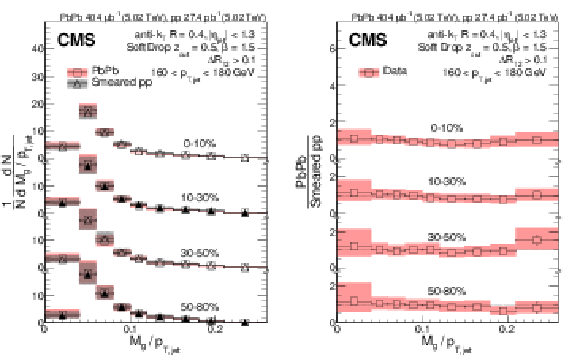
png pdf |
Figure 4:
(left) The centrality dependence of $ {{M_{\mathrm {g}}} / {{p_{\mathrm {T}}} ^\text {jet}}} $, for PbPb events with 160 $ < {{p_{\mathrm {T}}} ^\text {jet}} < $ 180 GeV for the (0.5,1.5) SD setting. Results are compared to the smeared pp spectra. (right) The ratio of PbPb data over smeared pp data. The heights of the vertical lines (colored boxes) indicate statistical (systematic) uncertainties. Statistical uncertainties are less than the marker sizes in most bins. |
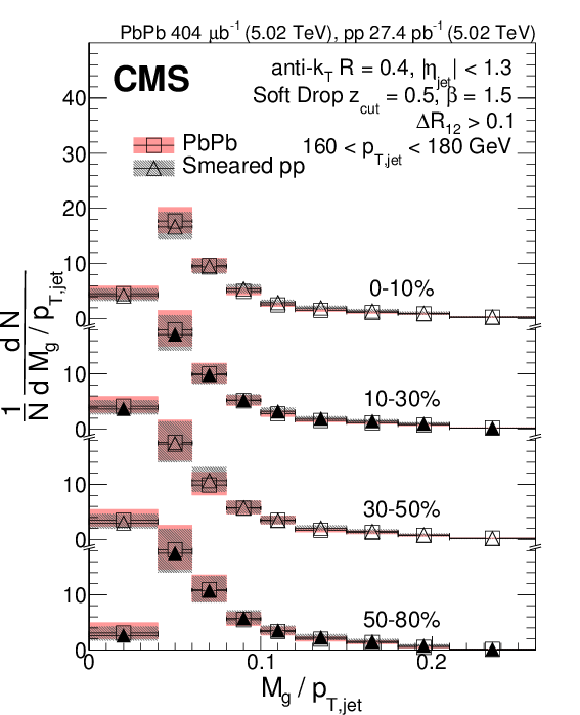
png pdf |
Figure 4-a:
The centrality dependence of $ {{M_{\mathrm {g}}} / {{p_{\mathrm {T}}} ^\text {jet}}} $, for PbPb events with 160 $ < {{p_{\mathrm {T}}} ^\text {jet}} < $ 180 GeV for the (0.5,1.5) SD setting. Results are compared to the smeared pp spectra. |

png pdf |
Figure 4-b:
The ratio of PbPb data over smeared pp data. The heights of the vertical lines (colored boxes) indicate statistical (systematic) uncertainties. Statistical uncertainties are less than the marker sizes in most bins. |
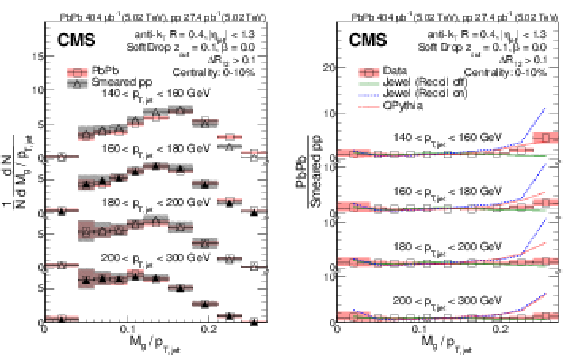
png pdf |
Figure 5:
(left) The $ {{p_{\mathrm {T}}} ^\text {jet}} $ dependence of $ {{M_{\mathrm {g}}} / {{p_{\mathrm {T}}} ^\text {jet}}} $, for PbPb events in the centrality class 0-10%, for the (0.1,0.0) SD setting. Results are compared to the smeared pp spectra. (right) The ratio of PbPb data over smeared pp data. The heights of the colored boxes indicate systematic uncertainties. Statistical uncertainties are less than the marker sizes. The ratios are compared to smeared JEWEL and Q-PYTHIA generators, shown in blue and green, respectively. |
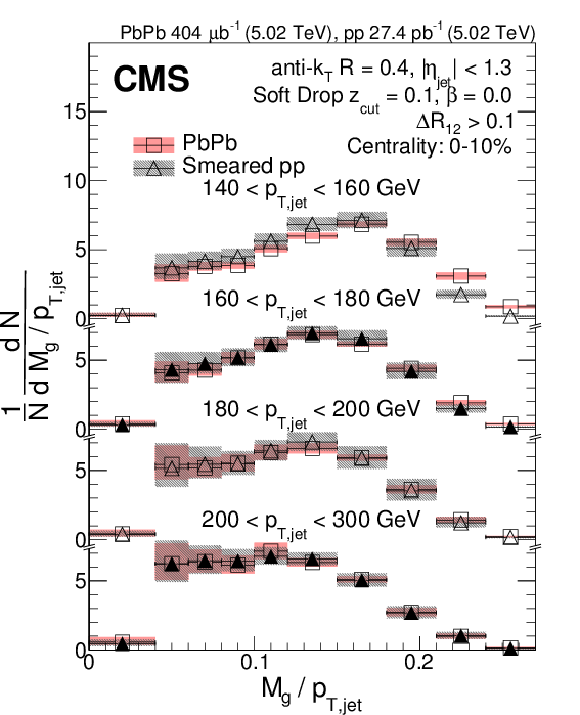
png pdf |
Figure 5-a:
The $ {{p_{\mathrm {T}}} ^\text {jet}} $ dependence of $ {{M_{\mathrm {g}}} / {{p_{\mathrm {T}}} ^\text {jet}}} $, for PbPb events in the centrality class 0-10%, for the (0.1,0.0) SD setting. Results are compared to the smeared pp spectra. |
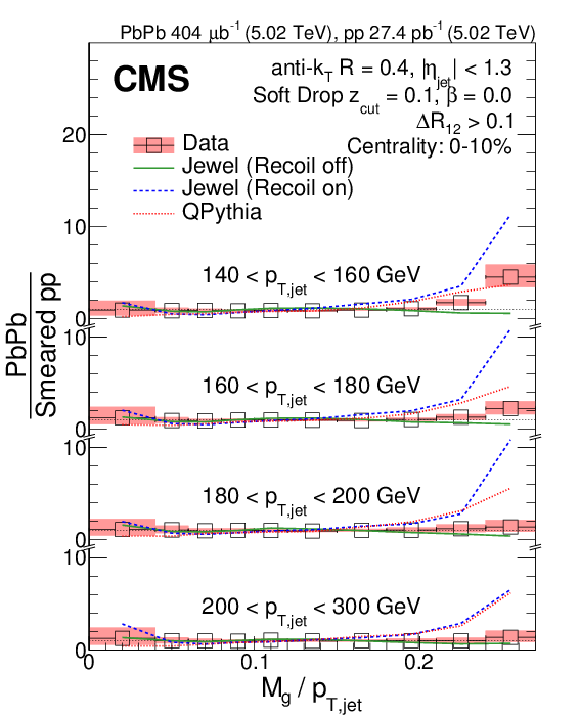
png pdf |
Figure 5-b:
The ratio of PbPb data over smeared pp data. The heights of the colored boxes indicate systematic uncertainties. Statistical uncertainties are less than the marker sizes. The ratios are compared to smeared JEWEL and Q-PYTHIA generators, shown in blue and green, respectively. |
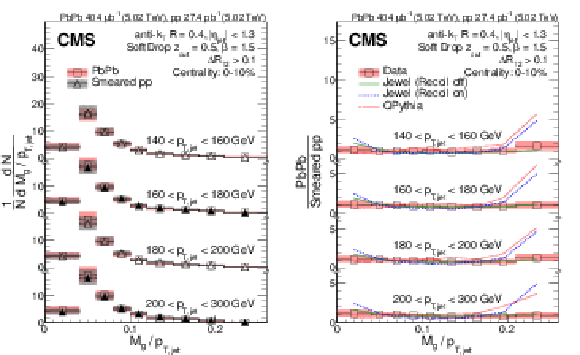
png pdf |
Figure 6:
(left) The $ {{p_{\mathrm {T}}} ^\text {jet}} $ dependence of $ {{M_{\mathrm {g}}} / {{p_{\mathrm {T}}} ^\text {jet}}} $, for PbPb events in the centrality class 0-10%, for the (0.5,1.5) SD setting. Results are compared to the smeared pp spectra. (right) The ratio of PbPb data over smeared pp data. The heights of the colored boxes statistical (systematic) uncertainties. Statistical uncertainties are less than the marker sizes. The ratios are compared to smeared JEWEL and Q-PYTHIA generators, shown in blue and green, respectively. |
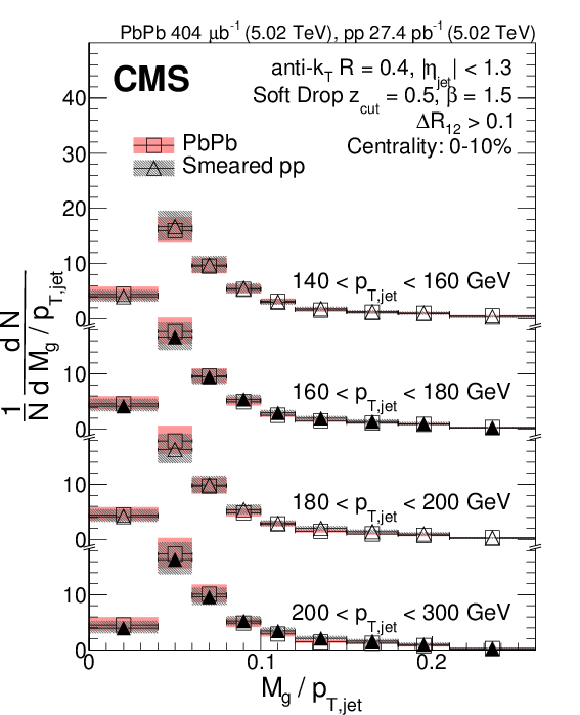
png pdf |
Figure 6-a:
The $ {{p_{\mathrm {T}}} ^\text {jet}} $ dependence of $ {{M_{\mathrm {g}}} / {{p_{\mathrm {T}}} ^\text {jet}}} $, for PbPb events in the centrality class 0-10%, for the (0.5,1.5) SD setting. Results are compared to the smeared pp spectra. |
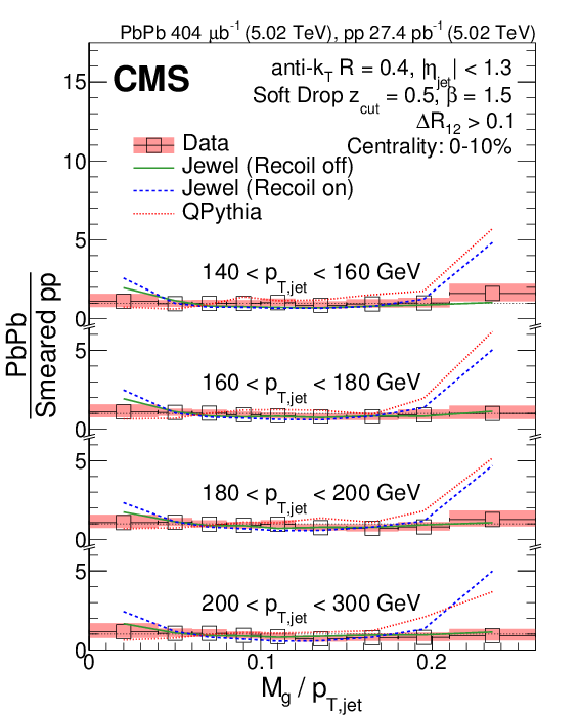
png pdf |
Figure 6-b:
The ratio of PbPb data over smeared pp data. The heights of the colored boxes statistical (systematic) uncertainties. Statistical uncertainties are less than the marker sizes. The ratios are compared to smeared JEWEL and Q-PYTHIA generators, shown in blue and green, respectively. |
| Summary |
|
The first measurements of the ratio of the groomed jet mass and the transverse momentum of the jet, $ {{M_{\mathrm {g}}} / {{p_{\mathrm {T}}} ^\text {jet}}} $, in pp and PbPb collisions at a nucleon-nucleon center-of-mass energy of 5.02 TeV are presented. Both the PYTHIA and HERWIG++ event generators reproduce the measurement in pp collisions. The results demonstrate that different grooming settings provide sensitivity to different parts of the phase space of subjet angular separation and momentum sharing. For soft drop (SD) grooming parameters that remove more radiation at distances far away from the jet axis, ($z_{\text {cut}}= $0.5, $\beta=$ 1.5), the $ {{M_{\mathrm {g}}} / {{p_{\mathrm {T}}} ^\text {jet}}} $ distribution in PbPb collisions is, within uncertainties, in agreement with that measured in pp collisions for all studied centrality (0-80%) and $ {{p_{\mathrm {T}}} ^\text {jet}} $ (140-300 GeV) regions. Using the ($z_{\text {cut}}= $ 0.1, $\beta= $ 0.0) SD setting, for which the grooming is independent of the angular separation of the subjets, no significant modification of the $ {{M_{\mathrm {g}}} / {{p_{\mathrm {T}}} ^\text {jet}}} $ spectra in 10-80% peripheral collisions with respect to the measurement in pp collisions is observed. However, for the 10% most central collisions, a hint of increased probability to produce jets with large $ {{M_{\mathrm {g}}} / {{p_{\mathrm {T}}} ^\text {jet}}} $ is seen when compared to pp collisions for jets with 140 $ < {{p_{\mathrm {T}}} ^\text {jet}} < $ 180 GeV. The difference between the results from the two examined grooming settings indicates that the region of phase space where modifications are most significant are splittings with large angular separation and low-to-moderate momentum sharing. The measurements are compared to the jet quenching event generators JEWEL and QPYTHIA, both of which predict a large enhancement at large $ {{M_{\mathrm {g}}} / {{p_{\mathrm {T}}} ^\text {jet}}} $ that is not observed in the data. |
| Additional Figures | |
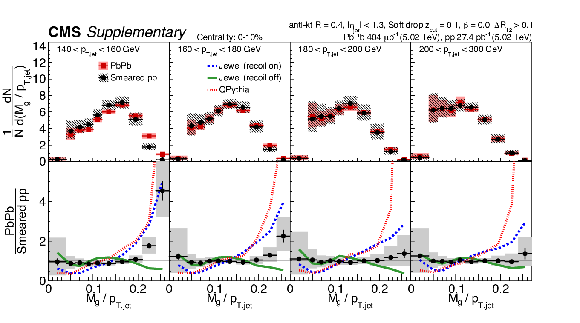
png pdf |
Additional Figure 1:
The $p_\text {T}^\text {jet}$ dependence of $M_\text {g}/p_\text {T}^\text {jet}$, for PbPb events in the centrality class 0-10% for the (0.1,0.0) SD setting. Results are compared to the smeared pp spectra. The ratio of PbPb data over smeared pp is also shown, and compared to jewel [1] and q-pythia [2] generators. The heights of the vertical lines (colored boxes) indicate statistical (systematic) uncertainties. |
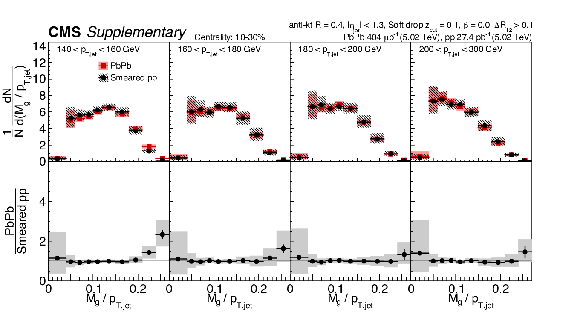
png pdf |
Additional Figure 2:
The $p_\text {T}^\text {jet}$ dependence of $M_\text {g}/p_\text {T}^\text {jet}$, for PbPb events in the centrality class 10-30% for the (0.1,0.0) SD setting. Results are compared to the smeared pp spectra. The ratio of PbPb data over smeared pp is also shown. The heights of the vertical lines (colored boxes) indicate statistical (systematic) uncertainties. |
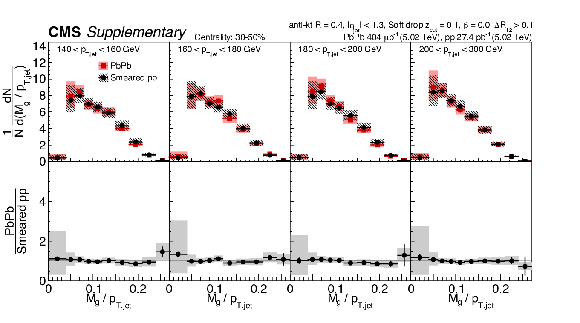
png pdf |
Additional Figure 3:
The $p_\text {T}^\text {jet}$ dependence of $M_\text {g}/p_\text {T}^\text {jet}$, for PbPb events in the centrality class 30-50% for the (0.1,0.0) SD setting. Results are compared to the smeared pp spectra. The ratio of PbPb data over smeared pp is also shown. The heights of the vertical lines (colored boxes) indicate statistical (systematic) uncertainties. |
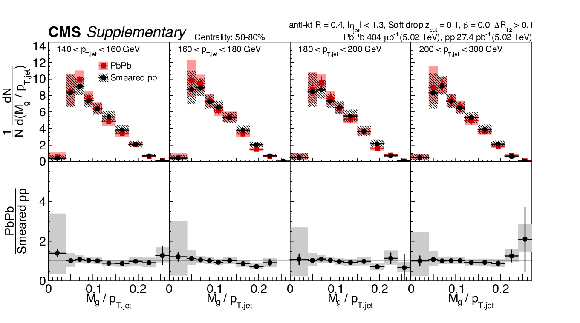
png pdf |
Additional Figure 4:
The $p_\text {T}^\text {jet}$ dependence of $M_\text {g}/p_\text {T}^\text {jet}$, for PbPb events in the centrality class 50-80% for the (0.1,0.0) SD setting. Results are compared to the smeared pp spectra. The ratio of PbPb data over smeared pp is also shown. The heights of the vertical lines (colored boxes) indicate statistical (systematic) uncertainties. |
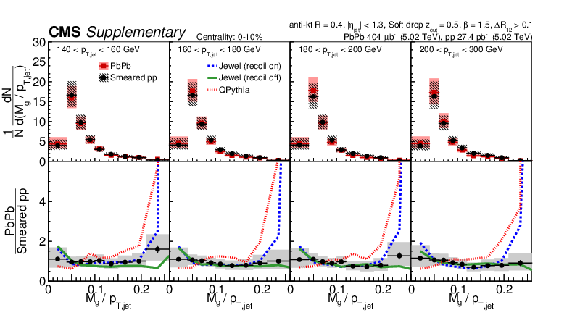
png pdf |
Additional Figure 5:
The $p_\text {T}^\text {jet}$ dependence of $M_\text {g}/p_\text {T}^\text {jet}$, for PbPb events in the centrality class 0-10% for the (0.5,1.5) SD setting. Results are compared to the smeared pp spectra. The ratio of PbPb data over smeared pp is also shown, and compared to the jewel [1] and q-pythia [2] generators. The heights of the vertical lines (colored boxes) indicate statistical (systematic) uncertainties. |
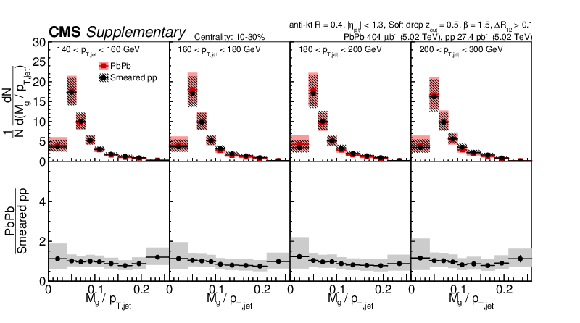
png pdf |
Additional Figure 6:
The $p_\text {T}^\text {jet}$ dependence of $M_\text {g}/p_\text {T}^\text {jet}$, for PbPb events in the centrality class 10-30% for the (0.5,1.5) SD setting. Results are compared to the smeared pp spectra. The ratio of PbPb data over smeared pp is also shown. The heights of the vertical lines (colored boxes) indicate statistical (systematic) uncertainties. |
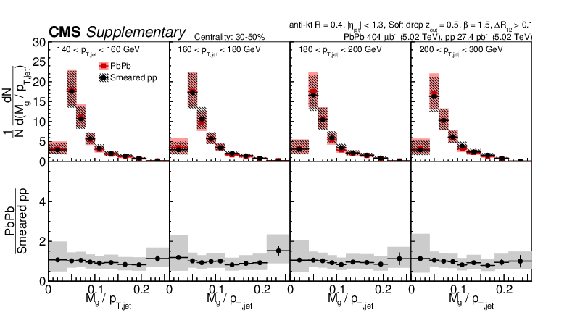
png pdf |
Additional Figure 7:
The $p_\text {T}^\text {jet}$ dependence of $M_\text {g}/p_\text {T}^\text {jet}$, for PbPb events in the centrality class 30-50% for the (0.5,1.5) SD setting. Results are compared to the smeared pp spectra. The ratio of PbPb data over smeared pp is also shown. The heights of the vertical lines (colored boxes) indicate statistical (systematic) uncertainties. |

png pdf |
Additional Figure 8:
The $p_\text {T}^\text {jet}$ dependence of $M_\text {g}/p_\text {T}^\text {jet}$, for PbPb events in the centrality class 50-80% for the (0.5,1.5) SD setting. Results are compared to the smeared pp spectra. The ratio of PbPb data over smeared pp is also shown. The heights of the vertical lines (colored boxes) indicate statistical (systematic) uncertainties. |
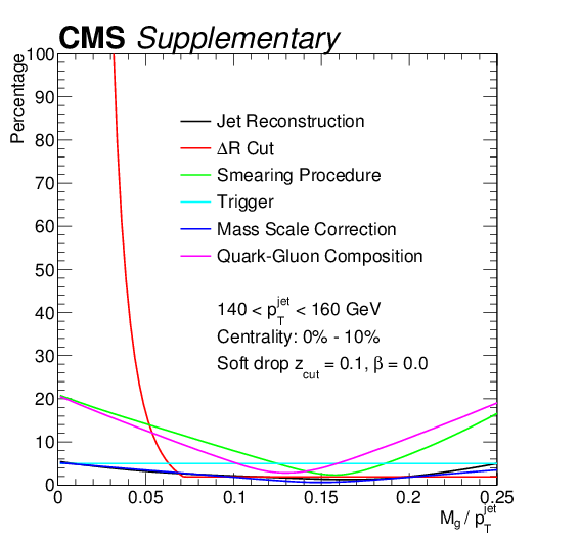
png pdf |
Additional Figure 9:
The $M_\text {g}/p_\text {T}^\text {jet}$ dependence of systematic uncertainties for the (0.1,0.0) SD setting for jets with 140 $ < p_\text {T}^\text {jet} < $ 160 GeV in an event in the centrality class 0-10%, expressed as percentages relative to the size of the mass spectrum at each $M_\text {g}/p_\text {T}^\text {jet}$ value. |

png pdf |
Additional Figure 10:
The $M_\text {g}/p_\text {T}^\text {jet}$ dependence of systematic uncertainties for the (0.5,1.5) SD setting for jets with 140 $ < p_\text {T}^\text {jet} < $ 160 GeV in an event in the centrality class 0-10%, expressed as percentages relative to the size of the mass spectrum at each $M_\text {g}/p_\text {T}^\text {jet}$ value. |

png pdf |
Additional Figure 11:
The $M_\text {g}/p_\text {T}^\text {jet}$ dependence of systematic uncertainties for the (0.1,0.0) SD setting for jets with 200 $ < p_\text {T}^\text {jet} < $ 300 GeV in an event in the centrality class 50-80%, expressed as percentages relative to the size of the mass spectrum at each $M_\text {g}/p_\text {T}^\text {jet}$ value. |

png pdf |
Additional Figure 12:
The $M_\text {g}/p_\text {T}^\text {jet}$ dependence of systematic uncertainties for the (0.5,1.5) SD setting for jets with 200 $ < p_\text {T}^\text {jet} < $ 300 GeV in an event in the centrality class 50-80%, expressed as percentages relative to the size of the mass spectrum at each $M_\text {g}/p_\text {T}^\text {jet}$ value. |
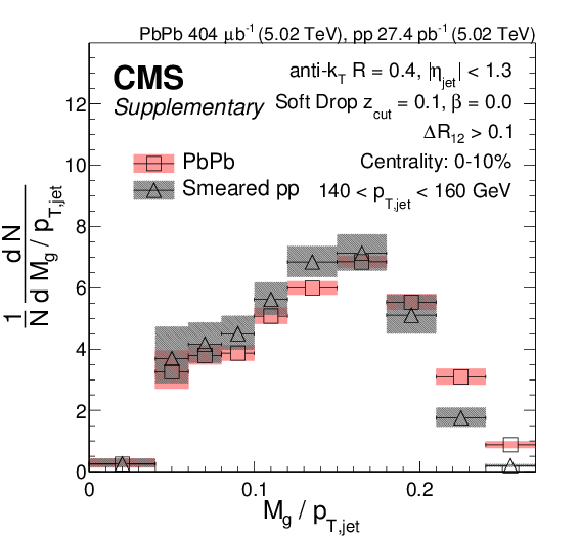
png pdf |
Additional Figure 13:
The $M_\text {g}/p_\text {T}^\text {jet}$ spectra, for events in the centrality class 0-10% for the (0.1,0.0) SD setting for jets with 140 $ < p_\text {T}^\text {jet} < 160$ GeV. Results are compared to the smeared pp spectrum. The height of the colored boxes indicate systematic uncertainties. The statistical uncertainties are smaller than the marker size. |

png pdf |
Additional Figure 14:
The ratio of $M_\text {g}/p_\text {T}^\text {jet}$ spectra of PbPb data over smeared pp, for events in the centrality class 0-10% for the (0.1,0.0) SD setting for jets with 140 $ < p_\text {T}^\text {jet} < $ 160 GeV. The data is compared to jewel [1] and q-pythia [2] generators. The height of the vertical lines (colored boxes) indicate statistical (systematic) uncertainties. |

png pdf |
Additional Figure 15:
The $M_\text {g}/p_\text {T}^\text {jet}$ spectra, for events in the centrality class 0-10% for the (0.5,1.5) SD setting for jets with 140 $ < p_\text {T}^\text {jet} < $ 160 GeV. Results are compared to the smeared pp spectrum. The height of the colored boxes indicate systematic uncertainties. The statistical uncertainties are smaller than the marker size. |
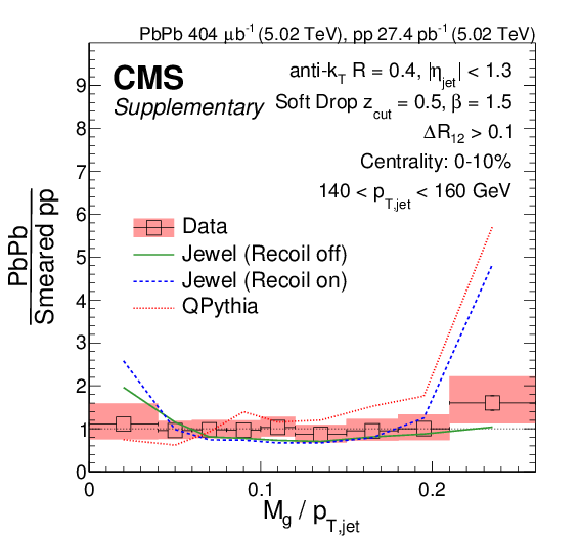
png pdf |
Additional Figure 16:
The ratio of $M_\text {g}/p_\text {T}^\text {jet}$ spectra of PbPb data over smeared pp, for events in the centrality class 0-10% for the (0.5,1.5) SD setting for jets with 140 $ < p_\text {T}^\text {jet} < $ 160 GeV. The data is compared to jewel [1] and q-pythia [2] generators. The height of the colored boxes indicate systematic uncertainties. The statistical uncertainties are smaller than the marker size. |
| References | ||||
| 1 | M. Gyulassy and M. Plumer | Jet quenching in dense matter | PLB 243 (1990) 432 | |
| 2 | R. Baier, Y. L. Dokshitzer, S. Peigne, and D. Schiff | Induced gluon radiation in a QCD medium | PLB 345 (1995) 277 | hep-ph/9411409 |
| 3 | PHENIX Collaboration | Suppressed $ \pi^{0} $ production at large transverse momentum in central Au+Au collisions at $ {\sqrt {\smash [b]{s_{_{\mathrm {NN}}}}}} = $ 200 GeV | PRL 91 (2003) 072301 | nucl-ex/0304022 |
| 4 | STAR Collaboration | Transverse momentum and collision energy dependence of high $ {p_{\mathrm{T}}} $ hadron suppression in Au+Au collisions at ultrarelativistic energies | PRL 91 (2003) 172302 | nucl-ex/0305015 |
| 5 | BRAHMS Collaboration | Transverse momentum spectra in Au+Au and d+Au collisions at $ {\sqrt {\smash [b]{s_{_{\mathrm {NN}}}}}} = $ 200 GeV and the pseudorapidity dependence of high $ p_\text{T} $ suppression | PRL 91 (2003) 072305 | nucl-ex/0307003 |
| 6 | PHOBOS Collaboration | Charged hadron transverse momentum distributions in Au+Au collisions at $ {\sqrt {\smash [b]{s_{_{\mathrm {NN}}}}}} = $ 200 GeV | PLB 578 (2004) 297 | nucl-ex/0302015 |
| 7 | CMS Collaboration | Observation and studies of jet quenching in PbPb collisions at $ \sqrt{s_{{NN}}} $~=~2.76 TeV | PRC 84 (2011) 024906 | CMS-HIN-10-004 1102.1957 |
| 8 | ATLAS Collaboration | Observation of a centrality-dependent dijet asymmetry in lead-lead collisions at $ {\sqrt {\smash [b]{s_{_{\mathrm {NN}}}}}}= $ 2.77 TeV with the ATLAS detector at the LHC | PRL 105 (2010) 252303 | 1011.6182 |
| 9 | ALICE Collaboration | Suppression of charged particle production at large transverse momentum in central Pb--Pb collisions at $ {\sqrt {\smash [b]{s_{_{\mathrm {NN}}}}}} = $ 2.76 TeV | PLB 696 (2011) 30 | 1012.1004 |
| 10 | CMS Collaboration | Measurement of transverse momentum relative to dijet systems in PbPb and pp collisions at $ {\sqrt {\smash [b]{s_{_{\mathrm {NN}}}}}} = $ 2.76 TeV | JHEP 01 (2016) 006 | CMS-HIN-14-010 1509.09029 |
| 11 | CMS Collaboration | Correlations between jets and charged particles in PbPb and pp collisions at $ \sqrt{s_{{NN}}}= $ 2.76 TeV | JHEP 02 (2016) 156 | CMS-HIN-14-016 1601.00079 |
| 12 | I. Vitev | Large angle hadron correlations from medium-induced gluon radiation | PLB 630 (2005) 78 | hep-ph/0501255 |
| 13 | T. Renk | Comparison study of medium-modified QCD shower evolution scenarios | PRC 79 (2009) 054906 | 0901.2818 |
| 14 | T. Renk | YaJEM -- a Monte Carlo code for in-medium shower evolution | Int. J. Mod. Phys. E 20 (2011) 1594 | 1009.3740 |
| 15 | N. Armesto et al. | Comparison of jet quenching formalisms for a quark-gluon plasma ``brick'' | PRC 86 (2012) 064904 | 1106.1106 |
| 16 | A. Majumder and J. Putschke | Mass depletion: a new parameter for quantitative jet modification | PRC 93 (2016) 054909 | 1408.3403 |
| 17 | S. D. Ellis, C. K. Vermilion, and J. R. Walsh | Recombination algorithms and jet substructure: Pruning as a tool for heavy particle searches | PRD 81 (2010) 094023 | 0912.0033 |
| 18 | J. M. Butterworth, A. R. Davison, M. Rubin, and G. P. Salam | Jet substructure as a new higgs-search channel at the LHC | PRL 100 (2008) 242001 | 0802.2470 |
| 19 | D. Krohn, J. Thaler, and L.-T. Wang | Jet trimming | JHEP 02 (2010) 084 | 0912.1342 |
| 20 | M. Dasgupta, A. Fregoso, S. Marzani, and G. P. Salam | Towards an understanding of jet substructure | JHEP 09 (2013) 29 | 1307.0007 |
| 21 | A. J. Larkoski, S. Marzani, G. Soyez, and J. Thaler | Soft drop | JHEP 05 (2014) 146 | 1402.2657 |
| 22 | C. A. Salgado and U. A. Wiedemann | Calculating quenching weights | PRD 68 (2003) 014008 | hep-ph/0302184 |
| 23 | Y. Mehtar-Tani and K. Tywoniuk | Groomed jets in heavy-ion collisions: sensitivity to medium-induced bremsstrahlung | JHEP 04 (2017) 125 | 1610.08930 |
| 24 | Y.-T. Chien and I. Vitev | Probing the hardest branching of jets in heavy ion collisions | PRL 119 (2017) 112301 | 1608.07283 |
| 25 | G. Milhano, U. A. Wiedemann, and K. C. Zapp | Sensitivity of jet substructure to jet-induced medium response | PLB 779 (2018) 409 | 1707.04142 |
| 26 | CMS Collaboration | Measurement of the splitting function in pp and PbPb collisions at $ \sqrt{s_{{{NN}}}}= $ 5.02 TeV | PRL 120 (2018) 142302 | CMS-HIN-16-006 1708.09429 |
| 27 | ALICE Collaboration | First measurement of jet mass in Pb-Pb and p-Pb collisions at the LHC | PLB 776 (2018) 249 | 1702.00804 |
| 28 | CMS Collaboration | The CMS experiment at the CERN LHC | JINST 3 (2008) S08004 | CMS-00-001 |
| 29 | CMS Collaboration | The CMS trigger system | JINST 12 (2017) P01020 | CMS-TRG-12-001 1609.02366 |
| 30 | M. Cacciari, G. P. Salam, and G. Soyez | Fastjet user manual | EPJC 72 (2012) 1896 | 1111.6097 |
| 31 | M. Cacciari, G. P. Salam, and G. Soyez | The anti-$ {k_{\mathrm{T}}} $ jet clustering algorithm | JHEP 04 (2008) 063 | 0802.1189 |
| 32 | CMS Collaboration | Particle-flow reconstruction and global event description with the CMS detector | JINST 12 (2017) P10003 | CMS-PRF-14-001 1706.04965 |
| 33 | O. Kodolova, I. Vardanyan, A. Nikitenko, and A. Oulianov | The performance of the jet identification and reconstruction in heavy ions collisions with CMS detector | EPJC 50 (2007) 117 | |
| 34 | CMS Collaboration | Charged-particle nuclear modification factors in PbPb and pPb collisions at $ \sqrt{s_{{N}{N}}}= $ 5.02 TeV | JHEP 04 (2017) 39 | CMS-HIN-15-015 1611.01664 |
| 35 | T. Sjostrand, S. Mrenna, and P. Skands | PYTHIA 6.4 physics and manual | JHEP 05 (2006) 026 | hep-ph/0603175 |
| 36 | CMS Collaboration | Study of the underlying event at forward rapidity in pp collisions at $ \sqrt{s} = $ 0.9, 2.76, and 7 TeV | JHEP 04 (2013) 072 | CMS-FWD-11-003 1302.2394 |
| 37 | I. P. Lokhtin and A. M. Snigirev | A model of jet quenching in ultrarelativistic heavy ion collisions and high-$ p_\mathrm{T} $ hadron spectra at RHIC | EPJC 45 (2006) 211 | hep-ph/0506189 |
| 38 | GEANT4 Collaboration | $ GEANT4--a $ simulation toolkiti | NIMA 506 (2003) 250 | |
| 39 | M. Bahr et al. | Herwig++ physics and manual | EPJC 58 (2008) 639 | 0803.0883 |
| 40 | M. H. Seymour and A. Siodmok | Constraining MPI models using $ \sigma_{\mathrm{eff}} $ and recent Tevatron and LHC underlying event data | JHEP 10 (2013) 113 | 1307.5015 |
| 41 | K. C. Zapp | JEWEL 2.0.0: directions for use | EPJC 74 (2014) 2762 | 1311.0048 |
| 42 | N. Armesto, L. Cunqueiro, and C. A. Salgado | Q-PYTHIA: A medium-modified implementation of final state radiation | EPJC 63 (2009) 679 | 0907.1014 |
| 43 | A. Dainese, C. Loizides, and G. Paic | Leading-particle suppression in high energy nucleus-nucleus collisions | EPJC 38 (2005) 461 | hep-ph/0406201 |
| 44 | G. O. V. de Barros, B. Fenton-Olsen, P. Jacobs, and M. Ploskon | Data-driven analysis methods for the measurement of reconstructed jets in heavy ion collisions at RHIC and LHC | NP A 910 (2013) 314 | 1208.1518 |
| 45 | P. Berta, M. Spousta, D. W. Miller, and R. Leitner | Particle-level pileup subtraction for jets and jet shapes | JHEP 06 (2014) 092 | 1403.3108 |
| 46 | CMS Collaboration | Determination of jet energy calibration and transverse momentum resolution in CMS | JINST 6 (2011) P11002 | CMS-JME-10-011 1107.4277 |
| 47 | CMS Collaboration | Jet energy scale and resolution in the CMS experiment in pp collisions at 8 TeV | JINST 12 (2017) P02014 | CMS-JME-13-004 1607.03663 |
| 48 | M. Dasgupta and G. P. Salam | Resummation of nonglobal QCD observables | PLB 512 (2001) 323 | hep-ph/0104277 |
| 49 | M. Dasgupta, A. Fregoso, S. Marzani, and A. Powling | Jet substructure with analytical methods | EPJC 73 (2013) 2623 | 1307.0013 |
| 50 | M. Dasgupta, A. Powling, and A. Siodmok | On jet substructure methods for signal jets | JHEP 08 (2015) 079 | 1503.01088 |
| 51 | A. J. Larkoski, I. Moult, and D. Neill | Non-global logarithms, factorization, and the soft substructure of jets | JHEP 09 (2015) 143 | 1501.04596 |
| 52 | Y. L. Dokshitzer, G. D. Leder, S. Moretti, and B. R. Webber | Better jet clustering algorithms | JHEP 08 (1997) 001 | hep-ph/9707323 |
| 53 | CMS Collaboration | Description and performance of track and primary-vertex reconstruction with the CMS tracker | JINST 9 (2014) P10009 | CMS-TRK-11-001 1405.6569 |
| 54 | ATLAS Collaboration | Measurement of the charged-particle multiplicity inside jets from $ \sqrt{s}= $ 8 TeV pp collisions with the ATLAS detector | EPJC 76 (2016) 322 | 1602.00988 |
| 55 | ATLAS Collaboration | Light-quark and gluon jet discrimination in pp collisions at $ \sqrt{s}= $ 7 TeV with the ATLAS detector | EPJC 74 (2014) 3023 | 1405.6583 |
| 56 | R. Kunnawalkam Elayavalli and K. C. Zapp | Medium response in JEWEL and its impact on jet shape observables in heavy ion collisions | JHEP 07 (2017) 141 | |
| 57 | R. Baier et al. | Radiative energy loss and $ p_\perp $ broadening of high-energy partons in nuclei | NPB 484 (1997) 265 | hep-ph/9608322 |

|
Compact Muon Solenoid LHC, CERN |

|

|

|

|

|

|